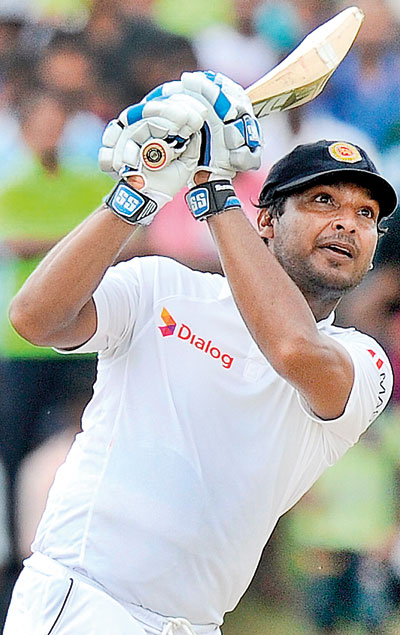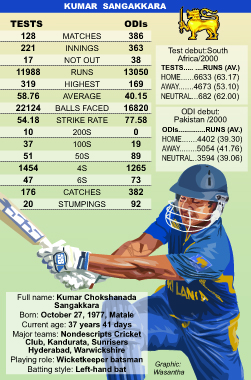Sanga: The rock of our age
View(s):He is the rock of Sri Lankan cricket. The word ‘resolve’ in its own right has a meaning, but, when one coins that word with Kumar Sangakkara it takes a different perspective altogether. Cricket-wise it becomes a statement so strong that not even the cricket establishment of Sri Lanka could  move it from what it stands for – not even an inch.
move it from what it stands for – not even an inch.
May be it was a twist of fate in Lankan cricket that moved Kumar towards cricket from his first love for tennis which he and his sister Saranga engaged in. His elder brother Veminda played for their alma mater, Trinity, for more than one season. But young Kumar who also played junior cricket was in the loop from that time. Yet, as he himself admits he was neither an Aravinda de Silva nor an Arjuna Ranatunga. In short Kumar Sangakkara was not a child prodigy.
As we have learned he is the keenest student of the game of cricket. He even takes the opinion of his father whenever the senior Sangakkara has one to share with his son. He is willing to learn and willing to work at it to perfection at the nets. Once I picked up his former team-mate Russell Arnold commenting while Kumar was at the crease at an International, “Just before he came into bat Kumar was at the nets for a long time”. That is the hallmark of a perfectionist who believes in living on top of the situation – always.
In the history of cricket there have been other cricketers who have been dubbed as the rock. Indian legend Rahul Dravid who stood to his stance defying whatever the opposing bowlers could offer more often than not has been described as the rock.
But, my perception of Kumar the ‘rock’ is different. This man stands for what is right in his own translation of the word rock – both on and off the field.
However, his words that spell out his thoughts are always as eloquent as his cover drive. Kumar in full flow in batting or sharing his thoughts has that branded finesse of an exquisite carving.
Yet, his batting has always been the door without a key between the authority and him. His batting has kept him inside the comfort zone — for him and the entire Lankan team, through many a season. But, the expression of his thoughts sometimes have left many an authority red faced and uncomfortable. Sangakkara’s Cowdrey oration made in 2011 was one of the most acclaimed worldwide. But, personally it did not bring him any trophies officially. At the same time it certainly did not go well with the authority.
Upon leaving school, Kumar joined Nondescript Cricket Club and only there did he see the game in its right perspective. It did not take very long for the then selectors to pick this promising young wicket-keeper who also could bat. Mind you this young bloke replaced the legendary Romesh Kaluwitharana.
The significance of his Test debut in 2000 at the Galle Stadium as a rookie was such that when he walked on to the crease to bat there was this guy by the name of Mahela Jayawardena, who was going great guns at the other end. Together they put on 81 runs against South Africa and this partnership has been growing in strength ever since. Sangakkara got out for 23 and Jayawardena went on to score 167. But, the partnership lived thereafter.
Six years later in 2006, Sangakkara, now a more mature player went to bat against the same opposition, but now as the regular No 3 with the score reading a bleak 1 for 6 and then 2 for 14.
By then the friendship had blossomed and his friend Mahela Jayawardena joined him at the crease as the Lankan captain.
 The duo took control of the game and when finally Kumar was out for 287, the pair had put on 624 against a South African attack that boasted of Dale Steyn and Makhaya Ntini.
The duo took control of the game and when finally Kumar was out for 287, the pair had put on 624 against a South African attack that boasted of Dale Steyn and Makhaya Ntini.
Then another memorable Sangakkara inning came in Australia in the same year when he scored a marathon 192 in Hobart in a close game that Sri Lanka lost purely for the reason that the umpire called it wrong to rule Kumar out caught behind.
It was Kumar who shone at the final that brought Sri Lanka its second World title – he scored the match winning inning for Sri Lanka in the ICC T-20 World Series final against India, in Bangladesh early this year.
With thirty seven test hundreds, he is only behind Sachin Tendulkar (51), Ricky Ponting (41) and Jacques Kallis (40), but has played a lesser number of Tests than the retired stalwarts.
In his last inning at the Hambantota Stadium, he became only the fourth international player to cross the 13,000 landmark in ODIs behind Tendulkar, Ponting and Sanath Jayasuriya.
The hallmark of his career is that he has stood by what he has believed in and that very factor had been bulwark in his stay at the crease, although some in authority may have liked to see an early end to his inning.
The more the pressure that was put on him, the more he answered them with his bat.
Kumar Sangakkara and Mahela Jayawardena have been outspoken and heard out through the cricketing world.
But, besides their batting deeds, they were also responsible for the creation of Angelo Mathews of today. They identified this youngster as a potential and brought him to the fore. The establishment fought against the idea, but, they let the truth sink into Lankan cricket. Then the authorities fought back by placing their gummy doll at the base, but, by doing so they only managed to break the soul of a budding young cricketer – hopefully not forever.
These are tricky times for Lankan cricket. As a result of bad management and planning, the younger brood are not in the position to take the challenge that the International cricket has to offer and only Angelo Mathews has withstood the real storm during the past few seasons.
It is more than likely that T.M. Dilshan, Mahela Jayawardena and may be some bowlers would call it a day after the World Cup. But, still there is a glimmer of hope with Sangakkara for the pure reason that he has not retired from either Test cricket or One Day Internationals.
Nevertheless, the pose at hand is — whether the authorities are prudent enough to persuade him to stay beyond the 2015 World Cup. Lankan cricket deserves and needs the input of a cricketer in the calibre of Sangakkara to go along with the game for at least another year.
The younger generation needs to play a while longer around him to recognise their own inner buddies.
But, if he decides to stay, they also must remember to leave the rock alone so that it would be a monument for the future Lankan cricketing generations.


